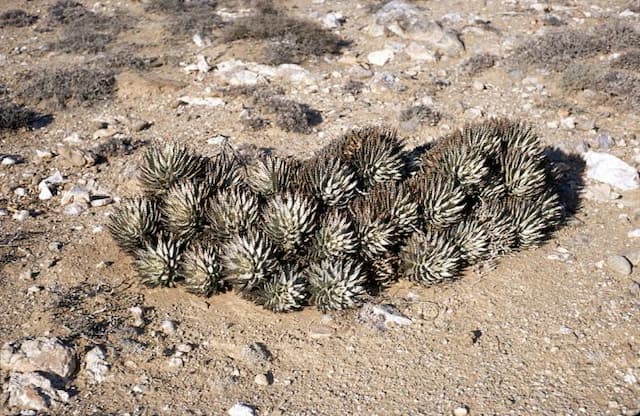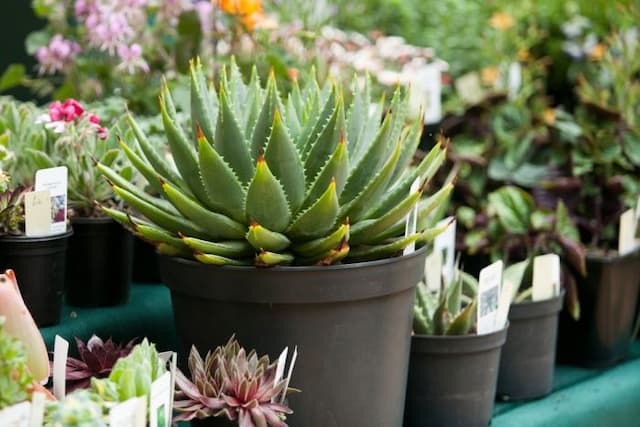Red hot poker Kniphofia caulescens

ABOUT
Commonly known as the Red hot poker, this perennial plant is admired for its distinctive flowering spikes. The blooms appear in a striking gradation of color, usually transitioning from a bright red at the top to a sunny yellow at the bottom, resembling a torch or poker hence its common name. These flame-like flower clusters sit atop a sturdy, upright stem. The foliage of the Red hot poker is equally attractive, with slender, arching leaves that possess a bluish-green hue. The leaves emerge from a basal clump, giving the plant a grassy appearance when not in bloom. Over the flowering season, the plant produces multiple flower spikes, adding vibrant colors to the garden when many other plants are beginning to fade. The blooms of the Red hot poker can also attract a variety of wildlife, including hummingbirds and bees, which are drawn to the nectar-rich flowers. After the flowering period, the spent spikes can be removed to encourage additional blooms or left on the plant for added interest in the landscape.
About this plant
 Names
NamesFamily
Asphodelaceae
Synonyms
Lesotho Red Hot Poker, Red Hot Poker, Torch Lily, Poker Plant
Common names
Kniphofia caulescens, Kniphofia caulescens var. caulescens, Tritoma caulescens
 Toxicity
ToxicityTo humans
Red hot poker (Kniphofia caulescens) is generally not considered toxic to humans. There are no significant reports of poisoning from ingesting parts of this plant, and it does not contain any well-known toxic substances that would be of concern for human health. However, it is always advisable to avoid ingesting parts of ornamental plants as a general safety precaution.
To pets
Red hot poker (Kniphofia caulescens) is not commonly listed as a toxic plant to pets such as dogs and cats. There are no widespread reports of toxicity in pets resulting from the ingestion of this plant. As with humans, while it does not contain known toxic compounds, it is still best to prevent pets from ingesting plants not intended for consumption.
 Characteristics
CharacteristicsLife cycle
Perennials
Foliage type
Evergreen
Color of leaves
Blue-green
Flower color
Mixed
Height
4 feet (1.2 meters)
Spread
2 feet (0.6 meters)
Plant type
Herb
Hardiness zones
5
Native area
South Africa
Benefits
 General Benefits
General Benefits- Attracts Pollinators: Kniphofia caulescens, commonly known as Red Hot Poker, draws in bees, butterflies, and hummingbirds, which are essential for pollination.
- Drought Tolerance: This plant is well adapted to dry conditions, requiring minimal irrigation once established, making it suitable for water-wise gardens.
- Visual Interest: With its striking flower spikes and grass-like foliage, it adds unique texture and color to garden designs.
- Low Maintenance: Red Hot Poker is known for being easy to care for, not requiring frequent pruning or special treatments.
- Deer Resistance: It is generally resistant to deer, which can be beneficial in areas where deer browsing is a problem for gardeners.
- Long Blooming: The plant has a long blooming season, often extending from late spring to early autumn, providing extended color in the garden.
- Cold Hardy: It can withstand cooler temperatures, making it a good choice for a variety of climates and extending its potential range.
 Medical Properties
Medical PropertiesThis plant is not used for medical purposes.
 Air-purifying Qualities
Air-purifying QualitiesThis plant is not specifically known for air purifying qualities.
 Other Uses
Other Uses- Hummingbird attraction: Red hot poker's tubular flowers are rich in nectar, making them attractive to hummingbirds, who act as pollinators.
- Decorative dried flowers: The flower spikes can be dried and used in floral arrangements, providing a unique and lasting element to bouquets.
- Bioindicator species: Red hot poker can be used as an indicator plant in gardens to signal the health of the ecosystem, as it thrives in well-maintained habitats.
- Natural fencing: Due to its size and structure, Red hot poker can be planted in rows to create an informal, low-lying garden barrier or fence.
- Garden thematic designs: The dramatic appearance of the Red hot poker can be used to create "fire-themed" garden sections or other thematic landscape designs.
- Companion planting: Red hot poker can be used in companion planting to enhance the growth of vegetables by attracting beneficial insects and deterring pests.
- Erosion control: The root system can help stabilize soil in areas that are prone to erosion, such as slopes or banks.
- Educational tool: Red hot poker can be used in school gardens or educational programs to teach about plant biology, pollination, and ecosystems.
- Photography subject: Its striking appearance makes Red hot poker an interesting subject for botanical photography, contributing to plant appreciation and identification.
- Culinary curiosity: Although not widely known for its edibility, some parts of the plant may be edible when cooked; however, it's essential to consult an expert to ensure safe consumption as this is not a common use.
Interesting Facts
 Feng Shui
Feng ShuiThe Red Hot Poker is not used in Feng Shui practice.
 Zodiac Sign Compitability
Zodiac Sign CompitabilityThe Red Hot Poker is not used in astrology practice.
 Plant Symbolism
Plant Symbolism- Attention-Grabbing: Often referred to as "Red Hot Poker" or "Torch Lily" due to its conspicuous and striking flower spikes, this plant symbolizes standing out and drawing attention in any setting.
- Courage and Boldness: The bright and fiery appearance of its blooms can be seen as a symbol of courage and the boldness to make a statement.
- Strength: Known for its robustness and ability to thrive in tough conditions, Kniphofia caulescens is often associated with strength and resilience.
 Water
WaterThe Red Hot Poker plant requires moderate watering, especially during the growing season in spring and summer. Water deeply when the top inch of soil feels dry to the touch, usually about once a week, providing about one to two gallons of water per session depending on the size of the plant and the weather conditions. Decrease watering in the fall and winter to prevent waterlogging, which this plant is particularly sensitive to. Avoid overhead watering to prevent disease and instead water at the base of the plant.
 Light
LightRed Hot Poker plants thrive best in full sunlight, requiring at least six hours of direct sun per day. Position the plant in a spot where it can receive unfiltered sunlight for optimal growth and bloom production. However, in extremely hot climates, a bit of afternoon shade can help prevent scorching of the leaves.
 Temperature
TemperatureRed Hot Poker plants are hardy and can tolerate a temperature range from 10 to 85 degrees Fahrenheit, but they grow best when the temperature is between 50 and 75 degrees Fahrenheit. They can survive mild frosts, but sustained temperatures below freezing can damage the plant.
 Pruning
PruningPruning Red Hot Poker plants is important to remove dead foliage and spent flower spikes, which encourages new growth and more prolific blooming. Prune the flowering stalks once they've faded and remove dead leaves in the spring. The best time for a thorough cleaning up is early spring, but deadheading can be done throughout the blooming season as needed.
 Cleaning
CleaningAs needed
 Soil
SoilRed Hot Poker plants thrive in rich, well-draining soil with a pH between 6.0 and 7.0. A mixture of garden soil, compost, and sandy soil or perlite will create an optimal growing medium.
 Repotting
RepottingRed Hot Poker plants are generally robust and do not need frequent repotting. Repotting every 3-5 years or when the plant outgrows its container is sufficient.
 Humidity & Misting
Humidity & MistingRed Hot Poker prefers moderate humidity levels but is tolerant of a wide range of humidity conditions, making it suitable for many garden environments.
 Suitable locations
Suitable locationsIndoor
Ensure bright light, well-draining soil, and occasional watering.
Outdoor
Plant in full sun, well-draining soil, and water moderately.
Hardiness zone
5-9 USDA
 Life cycle
Life cycleKniphofia caulescens, commonly known as Red Hot Poker or Torch Lily, begins its life cycle when seeds are sown in well-draining soil and germinate within a few weeks under the proper conditions. Once the seedlings emerge, they continue to grow into juvenile plants, developing a basal rosette of narrow, arching leaves. In the following growing seasons, these perennials will mature and establish a deep root system. Upon reaching maturity, usually in the second or third year, the Torch Lily produces tall, striking flower spikes bearing tubular flowers that range from red to orange or yellow, which are pollinated by birds, bees, and other insects. After the flowering period, the plant sets seed, which can be dispersed to give rise to new plants, thus continuing the cycle. During the plant's life, it undergoes periods of active growth in the warmer seasons and enters a phase of dormancy in colder weather, conserving energy for the next cycle of growth and flowering.
 Propogation
PropogationPropogation time
Spring to early summer
One of the most popular methods of propagating Kniphofia caulescens, commonly known as Red Hot Poker, is by division. This is typically done in the spring when the plant starts to show new growth. To propagate Red Hot Poker by division, carefully dig up an established clump and gently separate the crowns that have at least one growing point or fan of leaves. Make sure that each division has some roots attached. These separated crowns can then be replanted in a well-draining soil mix, ideally composed of garden soil and compost in equal parts, and watered in well. They should be planted at the same depth they were originally growing and spaced about 18 inches (approximately 45 centimeters) apart to allow adequate room for growth. Keep the soil moist but not waterlogged, and within a few weeks, the divisions should establish a new root system and start to grow actively.









